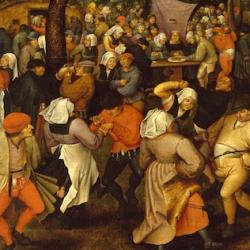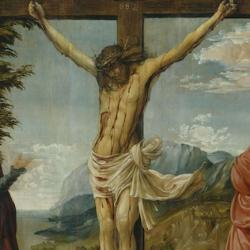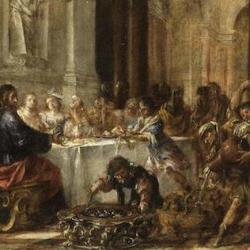I had the opportunity this week to listen to a series of sermons by Warren Gage of Knox Theological Seminary in Fort Lauderdale. Gage is an Assistant Professor of OT, but he did his doctoral work at the University of Dallas on the politics of John and Revelation, and did a lot of structural analysis of the two books in the process. The talks I heard concentrated on the structure of John and Revelation, and here are some of the salient points:
1) John and Revelation function like Luke-Acts, with Revelation completing the story that was begun in the gospel. Gage pointed out the various ways that the opening chapters of John “gesture” toward the end of Revelation. Early in John, Jesus is presented as a Bridegroom, but there is no bride until the end of Revelation. John begins his gospel with explicit allusions to Genesis 1 (“in the beginning”; imagery of light/darkness, etc.), and this is completed in the Genesis 2 imagery of Revelation 21-22. The word tabernacles with men, and at the end of Revelation this same imagery appears again. He connected the prediction to Nathaniel (Jn 1:51) to the vision of angels and the appearance of the son of man in Revelation 18-19; the angels are “ascending and descending” on the Son of Man, who is revealed as the rider on the white horse at the “peak” of the vision in Revelation. In this sense, then, John-Revelation tells one continuous story.
2) Gage also argued that both John and Revelation are chiastic, and that they run parallel. John 12 is the center of the gospel, and Revelation 12 is the center of Revelation. Jesus is lifted up on the cross in John 12, and in Revelation 12 he is exalted to rule with a rod of iron. Jesus says that the prince of this world is judged in John 12, and Satan is cast from heaven in Revelation 12.
3) One of the main themes of Gage’s talks was the identity of the whore of Babylon. His talks were radically preterist, as he described the theme of Revelation as the transformation of the whore into the bride, of the fallen old Israel into a beautiful new Israel. He did some wonderful riffs on the theme of wisdom as the “choice between two women,” a sapiential theme found in the patriarchal narratives, Solomon’s reign (the two whores), Proverbs, and so on.
4) The connection of John 4 with the patriarchal narratives is obvious, but Gage offered some fresh insights into the significance of the allusion. As Jesus comes to a well, any Jewish reader would recognize a marital setting, and the question would be, “What bride has the Lord chosen for the true Bridegroom?” The bride Jesus meets there is not the spotless or beautiful bride we expect, however, but a Samaritan woman with a checkered marital history. She is the first image in the Johannine literature of the whore that is to be transformed into the bride.
5) Mary Magdalene functions in the same way in John’s gospel. She had seven demons (like Israel in Jesus’ parable!), but by the end of the book has become a new Eve, recognizing Jesus as the New Adam in the garden of the resurrection. Since she is new Eve, it is entirely appropriate that Jesus call her “Woman.”
6) When we set John’s gospel alongside Revelation, Judas’s betrayal of Jesus matches the beast. This confirms that the beast (false prophet) arises from within the church, and also points to the typological significance of Judas, the prototype of the Judaizers.
7) Again matching John and Revelation, John 15 matches Revelation 14. The branches that are bearing fruit in John 15 are the same as the fruit-bearing vines of Revelation 14. This confirms Jim Jordan’s interpretation of Revelation 14 as a harvest of saints, rather than a judgment on the world.
This only scratches the surface of Gage’s rich treatment of John’s writings. A number of his studies are available at the Knox web site, and I trust he will someday have a more complete treatment in print. I await it eagerly.















